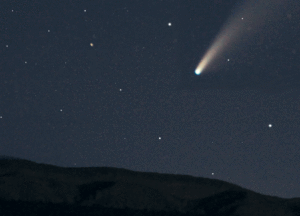By NICK YAMASHITA
The Progress

Area residents have had a chance of a lifetime over the past week. It has been an opportunity for some to take their focus from the coronavirus and other controversial worldly issues and to look up to the night skies for something much grander.
The Comet Neowise made its appearance during the last week in the northern hemisphere, being especially visible to local stargazers in the evening hours just after sunset.
“It has been incredible to see!” said Overton resident Alisha Anderson. “It is a once in 6,800 years kind of experience.”
Moapa Valley stargazers have resorted to dark places in the early evenings including the Mormon Mesa, Poverty Flats, Logandale Trails and even out towards Lake Mead. Mesquite stargazers have found there way out to Gold Butte, Bunkerville or out into the darkness of Mohave County, Arizona to catch the magical glow of the comet in the northwestern sky.
“The stargazing in this valley is amazing!” Anderson said of Moapa Valley.
Anderson explained that her interest in the comet started a couple of weeks ago when a few hobby astronomers whom she follows on social media had pictures and posts of the comet.
“Having a background in Earth Science and loving science, it peaked my interest and I did research and found out more about the comet,” she said. “It was even better when I found out the comet will not be back in Earth’s skies for 6,800 years.”
Anderson has stayed up until 3:30 a.m. when the comet was brighter and more visible.
The Comet Neowise was first spotted on March 27, 2020 by NEOWISE, an infrared optimized spacecraft telescope. NEOWISE is an anagram for Near-Earth Object Wide-field Infrared Space Explorer. It was officially determined to be a comet on March 30. Officially known as C/2020 F3, the comet measures about 5 km in diameter.
NEOWISE science team co-investigator Emily Kramer, under NASA supervision, calculated the size of the comet.
“Most comets are half dust and half water,” Kramer said. “This comet is about 13 million Olympic sized swimming pools of water. So that’s a lot of water.”
Though the comet is of massive size and traveling at great speeds of 40 miles per second, it poses no threat to Earth. It is approximately 70 million miles away, but is still very visible in the earthly night skies.
“Being up at 3:30 a.m. was a struggle for the first few days (of its appearance),” said Anderson. “I was so glad it eventually became visible just after sunset. It has been worth it though! I just wish I had a better camera.”
Having now seen this once in a 6,800 year astronomical rarity, Anderson was asked what she would like to see in the night sky next.
“Oooh that’s a tough question!” she said. “I dream of being able to see the Aurora Borealis or Aurora Australis. Cold temperatures are my least favorite and it would be quite a journey closer to one of the poles, but well worth it for water-colored skies filled with light.”
The Comet Neowise will be visible the rest of this week above the northwest horizon directly below the Big Dipper. It will be most visible on Tuesday, July 21.









